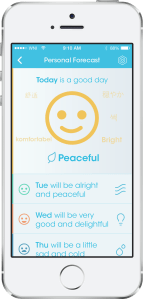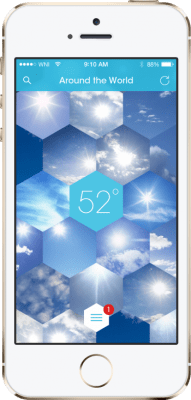Tokyo-based Weathernews Inc (WNI) already makes Japan’s top weather app with over 10 million downloads to date. So why does the company, one of the largest weather service providers in the world, want to enter the English-speaking market with a new iOS app called Sunnycomb that will vie for users against a hoard of other weather apps?
WNI’s new app gives it an opportunity to widen its net for crowdsourced data from a larger community of users around the world. And Sunnycomb is interesting enough to entice people away from popular apps by Yahoo and the Weather Channel.
It stands out from its many competitors for two reasons: a beautiful design that creates a mosaic of weather photos taken from other users, and a nifty feature that tries to predict how each day’s weather will make you feel.
When you first sign into the app, it prompts you to create a profile based on the weather conditions you are the most “sensitive” to, including temperature, rain or humidity. You are prompted to record how you feel about each day’s conditions by selecting an emoticon and entering a few words to describe the weather. After you make seven days of entries, Sunnycomb’s algorithm will start delivering a personalized report that not only forecasts the weather, but how you will probably feel about it.

Managing director Ishibashi Tomohiro says WNI decided to take this approach for its weather apps because even though people may be used to seeing forecasts for temperature, wind speed, humidity, atmospheric pressure or visibility, they don’t necessarily understand how all these factors feel when combined. Sunnycomb’s more intuitive approach is meant to make it easier for people to plan their commutes, outfits and each day’s activities.
“The most important thing about our forecast algorithm is that it includes user data, including their feelings and adjectives they use to describe the weather, in addition to the temperature or wind speed,” says Tomohiro. “We believe the most accurate weather sensor is human feelings and its worked by letting us provide the most accurate forecasts in Japan.”
The app also makes it easier for people to understand how weather fluctuations in nearby areas affect them, says Tomohiro. You can track the progress of a storm toward your city on a satellite map, but reading reports and seeing photos from people in places that have already been affected might give you a better idea of how serious it will be. Sunnycomb’s built-in translation engine lets users read reports from around the world. Other interesting features include the ability to comment on other users’ photos and the app’s “Skymatching” technology, which fetches reports and photos from places in the world with similar weather conditions as your area.
Sunnycomb from Weathernews Inc. on Vimeo.
Sunnycomb, which already has a user base that shares 100,000 reports a day, draws on WNI’s experience developing Weathernews Touch for the Japanese market. Tomohiro says the majority of Weathernews Touch’s users–about 80% to 85%–use it just to check the weather. But 10% to 15% are very actively engaged and upload photos and weather reports frequently, sometimes up to three times a day.
In addition to each user’s entries about the data and their mood, Sunnycomb also uses real-time forecasts from WNI, which employs 400 meteorologists in 15 countries across four continents, and other companies, including local weather services.
Founded in 1986 and listed on the Tokyo Stock Exchange (4825), WNI says it is now the largest private weather news service in the world. Its B2B services include information for shipping or navigation companies, as well as tools meant to help with disaster preparation.
WNI is still developing a monetization model for Sunnycomb. In Japan, Weathernews Touch monetizes with in-app purchases. Tomohiro says that 1.5 million users spend around around $3 per month for premium features. The company has big plans for Sunnycomb and the information gathers from the app’s users. WNI has already used crowdsourced data to help predict tide levels in Japan and hopes to bring similar services to the rest of the world.
“Having a weather app is the best way to establish our brand in the U.S., which is the biggest weather content market so far, with the Weather Channel and a lot of the other big guys based there,” says Tomohiro. “Our final goal is to perhaps predict disasters around the world or, in the longer term, understand global warming or climate change.”
